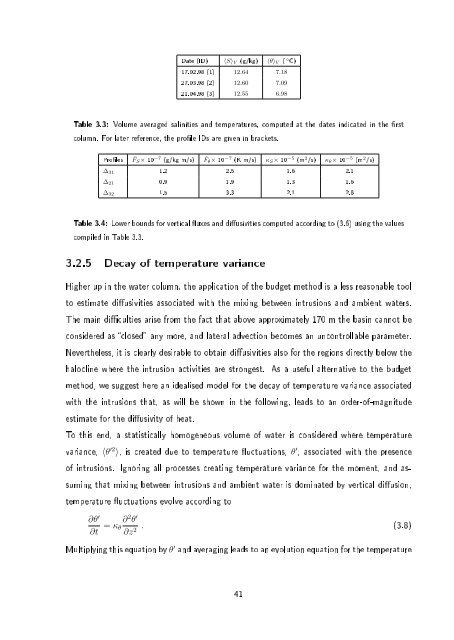Baltic Sea
Baltic Sea
Baltic Sea
Create successful ePaper yourself
Turn your PDF publications into a flip-book with our unique Google optimized e-Paper software.
Date (ID) 〈S〉 V (g/kg) 〈θ〉 V ( ◦ C)<br />
17.02.98 (1) 12.64 7.18<br />
27.03.98 (2) 12.60 7.09<br />
21.04.98 (3) 12.55 6.98<br />
Table 3.3: Volume averaged salinities and temperatures, computed at the dates indicated in the rst<br />
column. For later reference, the prole IDs are given in brackets.<br />
Proles ¯FS × 10 −7 (g/kg m/s) ¯Fθ × 10 −7 (K m/s) κ S × 10 −5 (m 2 /s) κ θ × 10 −5 (m 2 /s)<br />
∆ 31 1.2 2.5 1.6 2.1<br />
∆ 21 0.9 1.9 1.3 1.6<br />
∆ 32 1.5 3.3 2.1 2.8<br />
Table 3.4: Lower bounds for vertical uxes and diusivities computed according to (3.6) using the values<br />
compiled in Table 3.3.<br />
3.2.5 Decay of temperature variance<br />
Higher up in the water column, the application of the budget method is a less reasonable tool<br />
to estimate diusivities associated with the mixing between intrusions and ambient waters.<br />
The main diculties arise from the fact that above approximately 170 m the basin cannot be<br />
considered as closed any more, and lateral advection becomes an uncontrollable parameter.<br />
Nevertheless, it is clearly desirable to obtain diusivities also for the regions directly below the<br />
halocline where the intrusion activities are strongest. As a useful alternative to the budget<br />
method, we suggest here an idealised model for the decay of temperature variance associated<br />
with the intrusions that, as will be shown in the following, leads to an order-of-magnitude<br />
estimate for the diusivity of heat.<br />
To this end, a statistically homogeneous volume of water is considered where temperature<br />
variance, 〈θ ′2 〉, is created due to temperature uctuations, θ ′ , associated with the presence<br />
of intrusions. Ignoring all processes creating temperature variance for the moment, and assuming<br />
that mixing between intrusions and ambient water is dominated by vertical diusion,<br />
temperature uctuations evolve according to<br />
∂θ ′<br />
∂t = κ ∂ 2 θ ′<br />
θ<br />
∂z . (3.8)<br />
2<br />
Multiplying this equation by θ ′ and averaging leads to an evolution equation for the temperature<br />
41



